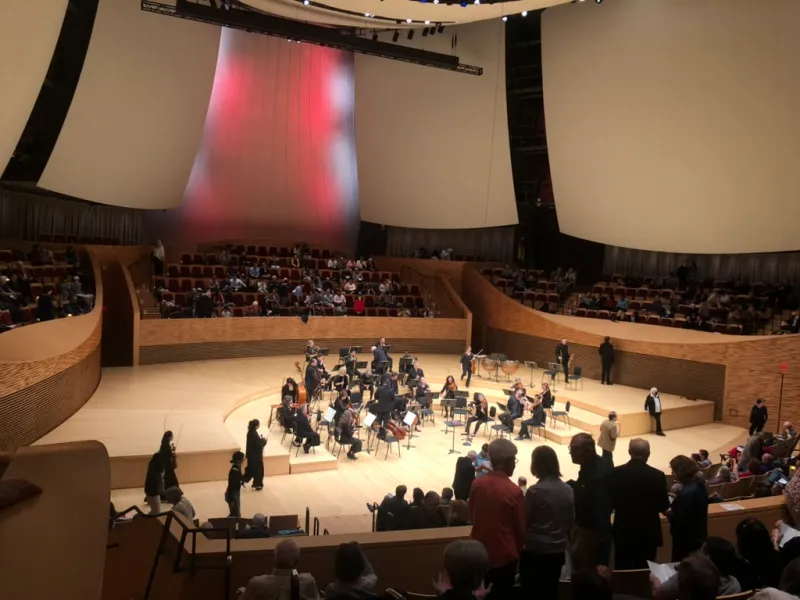Editor’s Note: This article is a review and includes subjective opinions, thoughts and critiques.
Have you ever wanted to travel back in time to listen to great composers perform iconic works for the first time? If you were at Bing Concert Hall on Friday, you would’ve certainly been in luck as the Philharmonia Baroque Orchestra featured violinist Shunske Sato in Felix Mendelssohn’s Violin Concerto and Ludwig van Beethoven’s Symphony No. 3 “Eroica.”
The ensemble performed on “period instruments,” similar in nature to those used during the historical music periods. The color and nuance the ensemble was able to bring with these instruments offered an interesting and enlightening listening experience.
Notable differences include instrument structure and material. Back in the day, horns lacked valves and woodwind instruments, like the flute, were made of wood rather than metal. Modern string instruments have metal and/or nylon strings, whereas historical instruments were played on gut strings.
Gut strings “have completely different properties,” Sato said. “They are more elastic and complex in structure, and so the sound also is warmer, more malleable. But it is also more difficult because you need to treat them in a very disciplined way.”
Mendelssohn’s Resurrection
The orchestra demonstrated their mastery of the period instruments in their lively rendition of Mendelssohn’s concerto, creating a colorful and pure soundscape right from the start of the first movement.
Sato presented a purity of sound that was highlighted through the lack of vibrato (small, rapid changes in pitch) and frequent portamentos (slides between notes), characteristics that were in agreement with the fingerings by violinist Ferdinand David, who originally premiered the work. Sato’s virtuosity shone through his tasteful use of dynamic contrast. The beautiful G major section soared through Mendelssohn’s beautifully crafted melodies — adventurous, rising scales and arpeggios moved listeners through whirlwinds of emotions.
In addition, the cadenza (a virtuosic solo passage in concerto) was treated in an unusually improvisatory manner which I really appreciated. The liberty taken in tempo fluctuation created a feeling of freedom.
The second movement was Sato’s color at his best: The way each note was played felt meticulously thought out, with two of the same notes never sounding the same. His freely moving melodies wove with the orchestra in a seamless manner.
Sato’s phenomenal technique was on full display in the third movement, with his effortless and light touch dancing through the myriad of notes. Yet at the same time, the violinist was able to contrast that lightness with well-controlled heaviness, offering for a exhilaratingly contoured ride through Mendelssohn’s finale.
It’s especially worth highlighting how well Sato and the Philharmonia blended together. Sato’s astute awareness of volume in relation to the orchestra made for a powerful, collaborative feeling. He even played along with the orchestra during sections that the soloist typically didn’t play in, providing seamless transitions between segments.
Outside of the strong ensemble, Sato’s portamentos and lack of vibrato in certain areas felt occasionally excessive. While I understand it was in alignment with the concept of historical performance, the frequency of the portamentos made me wonder about how strictly adherent one should be to historical performance and the merit that modern conventions, such as vibrato and clean note divisions, hold.
Beethoven’s Big Band
The orchestra’s performance of Beethoven’s symphony continued the theme of adhering to a historically accurate musical setting. Conductor Richard Egarr berates and rejects the modern day concert notion of silence during performances, citing that composers such as Beethoven and Mozart would actually hate it if there was no cheering during certain sections of their performances.
“Their performances were like what pop and jazz concerts are today,” Egarr said.
Modern-day classical music concerts, by contrast, discourage applause between movements. However, Egarr reiterated his disagreement with this perspective by beckoning the audience to applaud between movements of the Eroica symphony.
Concertgoers of the past were also vocal about disagreements with Beethoven’s music. To revive this convention, Egarr encouraged the audience to follow suit, joking that if there were disagreements with Beethoven’s music, they could speak with him after the concert.
One might have expected the music to feel limited since the Philharmonia used a smaller size orchestra, in line with the size of orchestras in the past. However, the diverse timbre provided a varied, lively interpretation.
Egarr also took time during the concert to describe the significance of the Eroica symphony. His introduction for the context of the piece helped me understand the symphony in a completely new light while listening.
For instance, he spoke to the innovative approach that Beethoven took to the final movement’s harmonic language. Audiences who heard the piece during Beethoven’s time were shocked by its sudden transitions to distant keys, which were abnormal features in the canon of classical music they were familiar with. As I kept an ear out for that while listening, I understood the shock audiences may have felt at the time and found delight in the genius of the music.
With the closing of the finale, the applause from the audience still thundering in my ears, I was left eagerly anticipating the next Philharmonia performance. There is much to look forward to: In addition to connecting audiences with authentic presentations of past musical settings, the orchestra has fostered a strong relationship with guest performers and Stanford Live, according to Stanford Live’s Director of Artistic Programming Laura Evans.
“This has been their 11th year at Bing,” Evans said. “I personally love the way [the Philharmonia] stewards relationships with special artists like [Sato], and it’s been a wonderful collaboration over these 10 years.”
